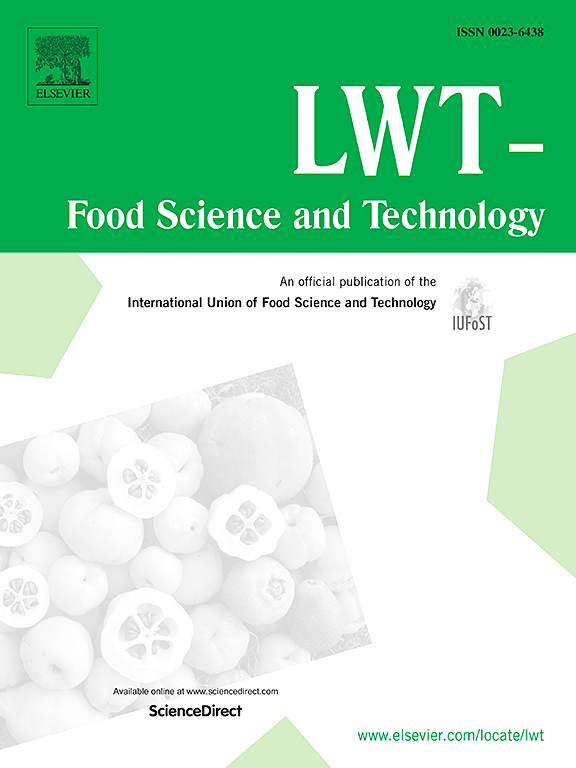Exploring microbial diversity and functionality in Verdejo wine vinegar fermentation through LC-MS/MS analysis
IF 6
1区 农林科学
Q1 FOOD SCIENCE & TECHNOLOGY
引用次数: 0
Abstract
The identification of microorganisms in vinegar production remains a challenge mainly, due to the difficulty of isolating and characterizing the microbiota involved. This implies that despite progress in understanding the composition and role of these microbial communities, there are still virtually unknown microorganisms in these environments. Metaproteomics reveals microbial diversity and behavior by analysis of proteins, offering precise insights into key moments and conditions in biological processes like acetification. This study consists of a thorough metaproteomic analysis during the elaboration of an innovative vinegar, Verdejo wine vinegar. Acetic acid fermentation occurred by submerged culture in an 8L automated Frings reactor operated in semi-continuous mode. LC-MS/MS identified 1626 proteins from 149 taxonomic groups, mainly Acetobacteraceae (1529), followed by yeast (47), lactic acid bacteria (29), and Archaea (21). Komagataeibacter (73.7%), Acetobacter (10.7%), Gluconacetobacter (1.7%), Novacetimonas (1.6%), and Gluconobacter (1.3%) were prevalent genera, with K. europaeus being the dominant species (56.7%). To our knowledge, this is the first metaproteomic approach to comprehensively address the study of so diverse microbial populations. GO Term analysis emphasized "heterocyclic compound binding" and "organic substance metabolic process", while analysis of protein-protein interactions identified key metabolic processes, such as amino acid biosynthesis, especially BCAAs, and crucial energetic pathways such as the TCA cycle. Stress response mechanisms, such as the dnaK-dnaJ-grpE and cl2p system, have been also highlighted. These analyses revealed the molecular and functional complexity of the acetification process, highlighting the critical importance of diverse metabolic routes in the adaptation of the microbiota members to the medium conditions. Overall, this study aims to characterize the microbiota driving Verdejo wine acetification and explore its composition, functions, and key metabolic processes.
通过 LC-MS/MS 分析探索 Verdejo 葡萄酒醋发酵过程中的微生物多样性和功能性
食醋生产中微生物的鉴定仍然是一项挑战,主要原因是很难分离和鉴定相关的微生物群。这意味着,尽管在了解这些微生物群落的组成和作用方面取得了进展,但在这些环境中仍然存在着几乎不为人知的微生物。元蛋白质组学通过分析蛋白质揭示了微生物的多样性和行为,为了解乙酸化等生物过程的关键时刻和条件提供了精确的视角。这项研究包括对一种创新醋--Verdejo 葡萄酒醋--的酿造过程进行全面的元蛋白质组分析。醋酸发酵是在半连续运行的 8 升自动弗林斯反应器中通过浸没式培养进行的。LC-MS/MS 鉴定出来自 149 个分类群的 1626 种蛋白质,主要是醋酸菌科(1529 种),其次是酵母菌(47 种)、乳酸菌(29 种)和古细菌(21 种)。主要菌属有 Komagataeibacter(73.7%)、Acetobacter(10.7%)、Gluconacetobacter(1.7%)、Novacetimonas(1.6%)和 Gluconobacter(1.3%),其中 K. europaeus 是优势种(56.7%)。据我们所知,这是第一种全面研究如此多样化微生物种群的元蛋白质组学方法。GO 术语分析强调了 "杂环化合物结合 "和 "有机物质代谢过程",而蛋白质-蛋白质相互作用分析则确定了关键的代谢过程,如氨基酸的生物合成,尤其是 BCAAs,以及关键的能量途径,如 TCA 循环。dnaK-dnaJ-grpE 和 cl2p 系统等应激反应机制也得到了强调。这些分析揭示了乙酸化过程在分子和功能上的复杂性,突出了不同代谢途径在微生物群成员适应培养基条件方面的关键重要性。总之,本研究旨在描述驱动 Verdejo 葡萄酒乙酸化的微生物群特征,并探索其组成、功能和关键代谢过程。
本文章由计算机程序翻译,如有差异,请以英文原文为准。
求助全文
约1分钟内获得全文
求助全文
来源期刊

LWT - Food Science and Technology
工程技术-食品科技
CiteScore
11.80
自引率
6.70%
发文量
1724
审稿时长
65 days
期刊介绍:
LWT - Food Science and Technology is an international journal that publishes innovative papers in the fields of food chemistry, biochemistry, microbiology, technology and nutrition. The work described should be innovative either in the approach or in the methods used. The significance of the results either for the science community or for the food industry must also be specified. Contributions written in English are welcomed in the form of review articles, short reviews, research papers, and research notes. Papers featuring animal trials and cell cultures are outside the scope of the journal and will not be considered for publication.
 求助内容:
求助内容: 应助结果提醒方式:
应助结果提醒方式:


